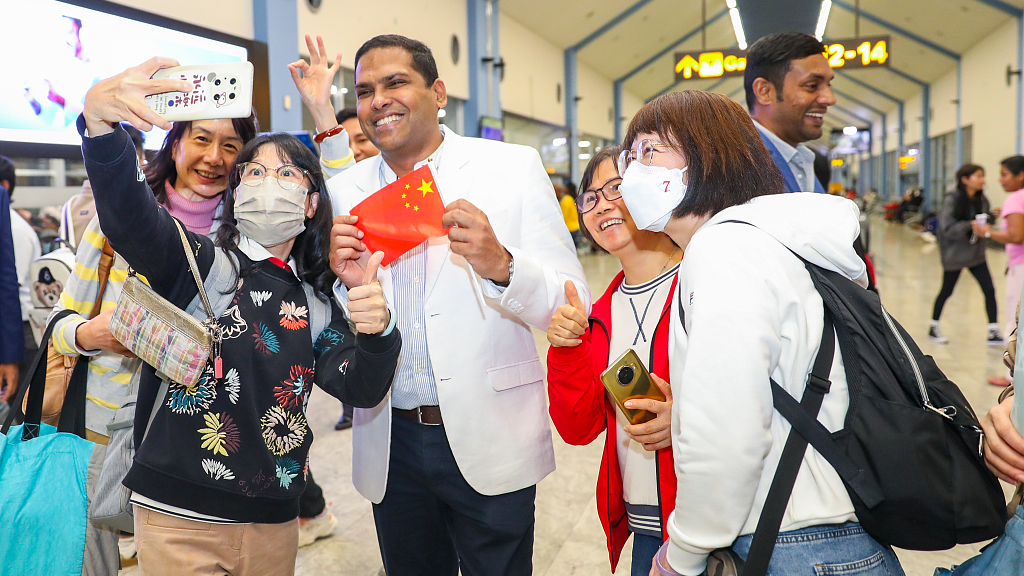
A Chinese tourist takes a selfie with Harin Fernando, the minister of tourism, in Colombo, Sri Lanka, March 1, 2023. /CFP
A Chinese tourist takes a selfie with Harin Fernando, the minister of tourism, in Colombo, Sri Lanka, March 1, 2023. /CFP
The global economy is expected to get a boost from a surge of Chinese tourists travelling abroad as the Labor Day break, one of the country's longest holidays, is unleashing the vast potential of their consuming power following three years of COVID when outbound travel was mostly restricted.
The reopening of the world's second largest economy at the beginning of this year injected much confidence into a severely battered global economy, with the international tourism market being notably expected to see a major recovery.
Chinese tourists contributed the most to the global tourism market, having spent about an average $260 billion annually during their overseas trips from 2015 to 2019 before the COVID-19 epidemic hit China, according to the World Tourism Organization of the United Nations.
This Labor Day break, starting from April 29 to May 3, is the first long holiday since China resumed outbound group tours in February, with many seizing the opportunity to embark on an adventure they hadn't been able to go on in the preceding three years.
Online searches for outbound flight tickets and overseas hotels for what is colloquially known as "the golden week" have recovered to 120 percent and 70 percent of that in the same period in 2019, respectively, according to a report by Minsheng Securities.
Meanwhile on Ctrip, a popular online travel agency in China, searches for outbound flight tickets were nine times more than that of the same period from last year, and reservation orders for outbound travel services were 18 times more.
The travel frenzy has taken place at a time when China's consumer demand is growing exponentially. On average, Chinese tourists are spending two times as much this year as they did in 2019 per trip, a report by Euromonitor International predicted. It also anticipated Chinese tourists to be the leading source of revenues for duty-free shops in six out of the 10 most important markets, significantly contributing to an estimated $117 billion in global sales revenues.
Sandiaga Uno, Indonesia's tourism minister, said he expected that the return of Chinese tourists will substantially help the tourism industry in ASEAN countries to recover. Ctrip data showed that Thailand, Singapore, Malaysia, Indonesia and the Philippines are among the top 10 outbound destinations for Labor Day tourists from the Chinese mainland.

Ctrip data showed that Thailand, Singapore, Malaysia, Indonesia and the Philippines are among the top 10 outbound destinations for Labor Day tourists from the Chinese mainland. /Xinhua
Ctrip data showed that Thailand, Singapore, Malaysia, Indonesia and the Philippines are among the top 10 outbound destinations for Labor Day tourists from the Chinese mainland. /Xinhua
In Thailand, where the tourism industry makes up about one-fifth of its GDP, Chinese tourists are expected to leave an impressive imprint on the country's economic recovery, especially during the Labor Day break. In 2019, Chinese tourists accounted for one-third of all tourists there.
The spillover effects of China's travel surge have propelled nations to keep their gates wide open. Countries from Southeast Asia to western Europe have retrofitted their travel policies to accommodate, or introduced incentives to attract, Chinese tourists.
Starting from Monday, German embassies and consulates in China have resumed accepting tourist visa applications, making Germany the latest country to follow Japan, South Korea and many European Union countries that successively lifted travel restrictions imposed on Chinese visitors.
Thailand's Tourism Ministry said it would actively cooperate with airlines to increase the number of commercial flights to the country, while the Japanese embassy in China held a grand event promoting Japan tours.